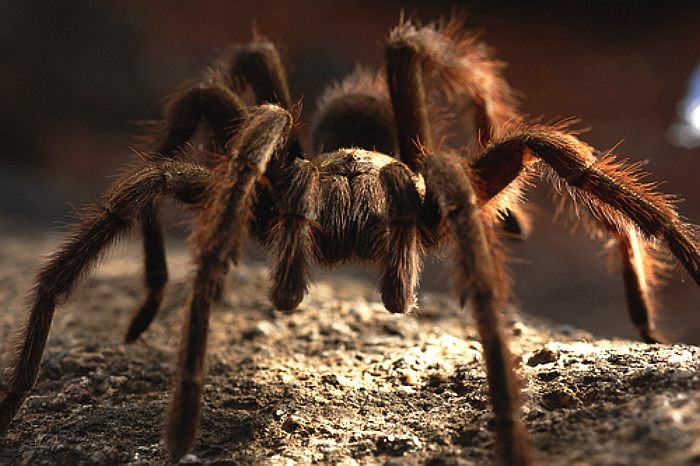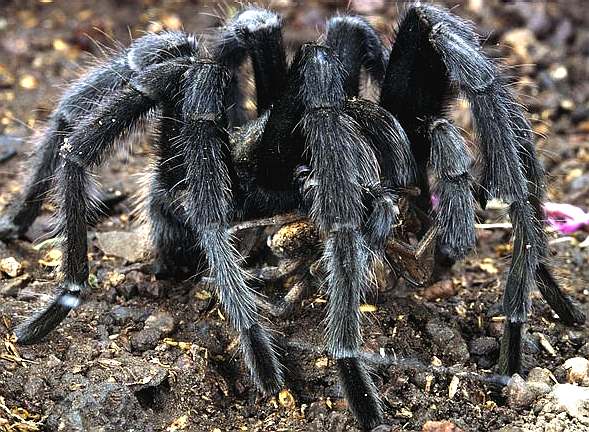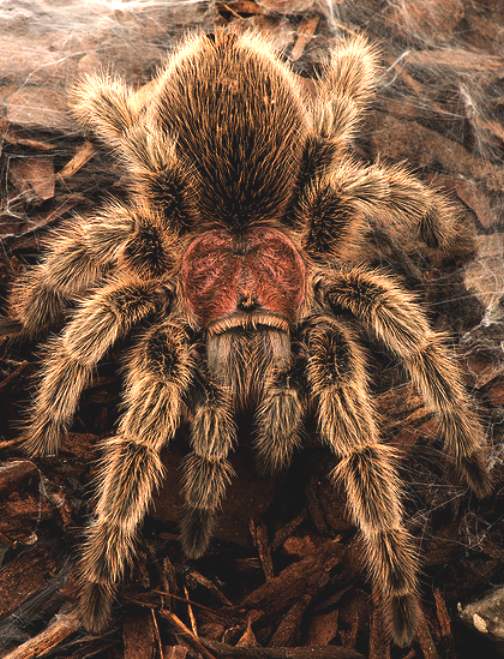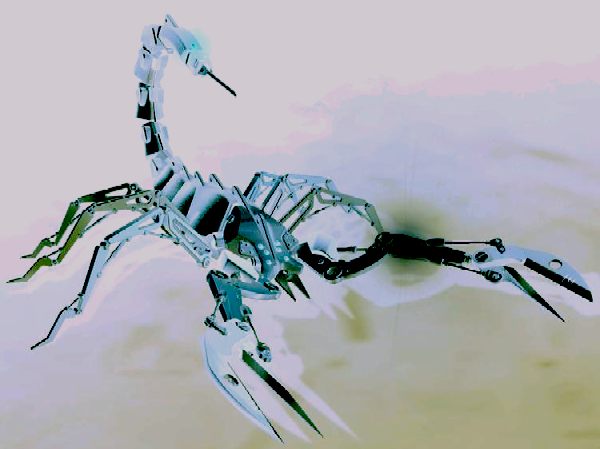
Tarantulas (as the term is used in North America) comprise a group of often hairy and very large arachnids belonging to the Theraphosidae family of spiders, of which approximately 900 species have been identified.
A tarantula doesn't use a web to ensnare prey, though it may spin a trip wire to signal an alert when something approaches its burrow. These spiders grab with their appendages, inject paralyzing venom, and
pierce their victims with their fangs. Tarantulas also secrete digestive enzymes to liquefy their victims' bodies so that they can suck them up through their straw-like mouth openings. After a large meal, the tarantula may not need to eat for a month.
Tarantulas have few natural enemies, with the exception of the parasitic pepsis wasps. Such a wasp will paralyze a tarantula with its sting and lay its eggs on the spider's body. When the eggs hatch, wasp larvae gorge themselves on the still living tarantula.
The tarantula's mating ritual begins when the male spins a web and deposits sperm on its surface. He copulates by using his pedipalps (short, leglike appendages located near the mouth) and then scuttles away if he can—females sometimes eat their mates.
Females seal both eggs and sperm in a cocoon and guard it for six to nine weeks, when some 500 to 1,000 tarantulas hatch.

Some genera of tarantulas hunt prey primarily in trees; others hunt on or near the ground. All tarantulas can produce silk—while arboreal species will typically reside in a silken "tube tent", terrestrial species will line their burrows with silk to stabilize the burrow wall and facilitate climbing up and down. Tarantulas mainly eat insects and other arthropods, using ambush as their primary method of prey capture. The biggest tarantulas can kill animals as large as lizards, mice, birds and small snakes. They can be found in the south and western parts of the United States, Central America, and throughout South America. Tarantulas can also be found throughout Africa, large parts of Asia and all over
Australia. In Europe, there are some species in
Spain, Portugal, Turkey, Italy, and in
Cyprus. Most tarantulas are harmless to humans, and some species are popular in the exotic pet trade. All tarantulas are venomous, but only some species have venom that, while not known to have ever produced human fatalities, can produce extreme discomfort over a period of several days.
Like all arthropods, the tarantula is an invertebrate that relies on an exoskeleton for muscular support. A tarantula’s body consists of two main parts, the prosoma (cephalothorax) and the opisthosoma (abdomen). The prosoma and opisthosoma are connected by the pedicle, or what is often called the pregenital somite. This waist-like connecting piece is actually part of the prosoma and allows the opisthosoma to move in a wide range of motion relative to the
prosoma.
The sizes range from as small as a fingernail to as big as a dinner plate. Depending on the species, the body length of tarantulas ranges from 2.5 to 10 centimetres (1 to 4 in), with 8–30-centimetre (3–12 in) leg spans. Leg span is determined by measuring from the tip of the back leg to the tip of the front leg on the opposite side. The largest species of tarantula can weigh over 85 grams (3 oz). The largest of all, the goliath birdeater (Theraphosa blondi) from Venezuela and Brazil, has been reported to have a weight of 150 grams (5.3 oz) and a leg-span of up to 30 centimetres (12 in), males being the longer and females greater in girth.
T. apophysis (the pinkfoot goliath) was described 187 years after the goliath birdeater; therefore its characteristics are not as well attested.T. blondi is generally thought to be the heaviest tarantula, and T. apophysis to have the greatest leg span. Two other species, Lasiodora parahybana (the Brazilian salmon birdeater) and L. klugi, rival the size of the two goliath spiders.
The majority of North American tarantulas are brown. Elsewhere have been found species colored cobalt blue (Haplopelma lividum), black with white stripes (Aphonopelma seemanni), yellow leg markings (Eupalaestrus campestratus), metallic blue legs with vibrant orange abdomen and greenbottle blue (Chromatopelma cyaneopubescens). Their natural habitats include savanna, grasslands such as the pampas, rainforests, deserts, scrubland, mountains, and cloud forests. They are generally classed among the terrestrial types. They are burrowers that live in the ground.
Tarantulas are becoming increasingly popular as pets and are readily available in captivity.
FOSSIL
RECORD
Although there are fossils of mygalomorph spiders going back to the Triassic, only two specimens have been found so far which can be convincingly assigned to Theraphosidae. One is from Dominican Republic amber, the other from Chiapas
(Mexican) amber. Both these ambers are quite young, being Miocene in age or about 16 million years old.
Tarantula
National Geographic
BITES
and URTICATING HAIRS
Despite their often threatening appearance and reputation, no tarantula has been known to have a bite that is deadly to humans. In general, the effects of the bites of all kinds of tarantula are not well known. While the bites of many species are known to be no worse than a wasp sting, accounts of bites by some species are reported to be very painful and to produce intense spasms that may recur over a period of several days; the venom by the African tarantula Pelinobius muticus also causes strong
hallucinations. In all cases, it is prudent to seek medical aid. Because other proteins are included when a toxin is injected, some individuals may suffer severe symptoms due to an allergic reaction rather than to the venom. Such allergic effects can be life-threatening.
Before biting, tarantulas may signal their intention to attack by rearing up into a "threat posture", which may involve raising their prosoma and lifting their front legs into the air, spreading and extending their fangs, and (in certain species) making a loud hissing by stridulating. Their next step, short of biting, may be to slap down on the intruder with their raised front legs. If that response fails to deter the attacker, the tarantulas of the Americas may next turn away and flick urticating hairs toward the pursuing predator. The next response may be to leave the scene entirely, but, especially if there is no line of retreat, their final response may also be to whirl suddenly and bite. Some tarantulas are well known to give "dry bites," i.e., they may defensively bite some animal that intrudes on their space and threatens them, but they will not pump venom into the wound.

New-world tarantulas (those found in North and South America) are equipped with urticating hairs on their abdomen, and will almost always throw these barbed hairs as a first line of defense. These hairs will irritate sensitive areas of the body and especially seem to target curious animals who may sniff these hairs into the mucous membranes of the nose. Some species have more effective urticating hairs than others. The Goliath Birdeater is one species known for its particularly irritating urticating hairs. Urticating hairs can penetrate the cornea so eye protection should be worn when handling such
tarantulas.
Old-world tarantulas (from Europe, Africa, Asia and Australia) have no urticating hairs and are more likely to attack when disturbed. Old-world tarantulas often have more potent, medically significant venom.
There are dangerous spider species which are related to tarantulas and frequently confused with them. A popular urban
legend maintains that deadly varieties of tarantula exist somewhere in South America. This claim is often
made without identifying a particular spider, although the "banana tarantula" is sometimes
named. A likely candidate for the true identity of this spider is the dangerous Brazilian wandering spider Phoneutria nigriventer, of the family
Ctenidae, as it is sometimes found hiding in clusters of bananas and is one of several spiders called the "banana spider." It is not technically a tarantula but it is fairly large (4–5 inches long), somewhat hairy, and is highly venomous to
humans. Another dangerous type of spider that has been confused with
tarantulas is the Australasian funnel-web spider. The best known of these is the Sydney funnel-web spider Atrax robustus, a spider that is aggressive, highly venomous, and (prior to the development of antivenin in the 1980s) was responsible for
numerous deaths in Australia. These spiders are members of the same suborder as
tarantulas. (Some Australians use the slang term 'triantelope' for large, hairy, and harmless members of the Huntsman spider family which are often found on interior household walls and in
automobiles.)
Tarantula
Movie 1957
Medical implications
While no fatalities have been attributed to tarantula bites, sometimes spider bites are regarded as the probable source of infections. Medical advice regarding prophylaxis may be helpful in that regard. In addition, there is considerable anecdotal evidence[citation needed] indicating that the venoms of some old-world species can produce symptoms so severe that medical treatment would be appropriate. Medical intervention is also regarded as appropriate when symptoms such as breathing difficulty or chest pain develop, since these conditions may indicate an anaphylactic reaction. As with bee stings, allergic reactions to protein fractions may be many times more dangerous than the direct toxic effects of the venom.
Urticating hairs may cause medical problems for humans should they enter the eyes or the respiratory system. Unless one inhales air heavily laden with these hairs or rubs them into one's eyes, they are rarely a problem. Some individuals are more sensitive to skin contact with these spines and learn to avoid them when cleaning cages or otherwise coming into potential contact with them.
Sexual dimorphism
Some tarantula species exhibit pronounced sexual dimorphism. Males tend to be smaller (especially their abdomens, which can appear quite narrow) and may be dull in color when compared to their female counterparts, as in the species Haplopelma lividum. Mature male tarantulas also may have tibial hooks on their front legs, which are used to restrain the female's fangs during copulation.
A juvenile male's sex can be determined by looking at a cast exuvium for exiandrous fusillae or spermathecae. Females possess spermathecae except for the species Sickius longibulbi and Encyocratella
olivacea. Ventral sexing is difficult, but, if done correctly, it can be relatively reliable. Males have much shorter lifespans than females because they die relatively soon after maturing. Few live long enough for a post-ultimate moult. It is unlikely that it happens much in natural habitats because they are vulnerable to predation, but it has happened in captivity if rarely. Most males do not live through this moult as they tend to get their emboli, mature male sexual organs on pedipalps, stuck in the moult. Most tarantula fanciers regard females as more desirable as pets due to their much longer lifespan. Wild caught tarantulas are often mature males because they wander out in the open and are more likely to be caught.

TARANTULA
THE MOVIE
Tarantula is a 1955 science fiction film directed by Jack Arnold, and starring Leo G. Carroll, John Agar, and Mara
Corday.
Plot summary
The plot concerns a biological researcher, Professor Gerald Deemer, who is trying to prevent the food shortages which will result from the world's expanding population. With the help of atomic science, he invents a special nutrient on which animals can live exclusively, but which causes them to grow to many times their normal size. In his laboratory, he houses several oversized rodents and Mexican red rumped tarantula's.
When his researchers try the nutrient, they develop runaway acromegaly. One of them is driven mad, half destroys the lab (freeing the animals), and attacks Deemer, injecting him with the solution. The tarantula is one of the creatures freed. As a result, Deemer gradually becomes more and more deformed while the now-gigantic tarantula ravages the countryside. A sympathetic doctor, Matt Hastings, and Deemer's female assistant, Stephanie Clayton, investigate the mystery of the clean-picked animal bones and eight-foot pools of arachnid venom, which the spider leaves behind: it also wrecks the Deemer lab. The spider is eventually destroyed, after several failed attempts, by a napalm attack launched from a jet fighter squadron.
The film's poster, featuring a spider with two eyes instead of the normal eight and carrying a woman in its fangs, does not represent any scene in the film.
Cast
Leo G. Carroll as Prof. Gerald Deemer
John Agar as Dr. Matt Hastings
Mara Corday as Stephanie Clayton
Nestor Paiva as Sheriff Jack Andrews
Ross Elliott as Joe Burch
Edwin Rand as Lt. John Nolan
Raymond Bailey as Townsend
Hank Patterson as Josh
Bert Holland as Barney Russell
Steve Darrell as Andy Andersen
Production
The special effects for both the giant animals and the unfortunate scientist's deformity are fairly advanced for the time, with real animals (including a rabbit and a guinea pig in Professor Deemer's lab) being used to represent the giant creatures. A real spider was also used for shots where the whole monster was shown, with models reserved for close-ups (and its skyscraper-sized version), resulting in a rather more convincing monster than the giant ants in the earlier big-bug film Them!
(1954).
The movie was filmed in and around the rock formations of "Dead Man's Point" in Lucerne Valley California, a frequently used movie location for many early western films. It takes place in the fictional town of Desert Rock,
Arizona.
Like Them!, Tarantula makes atmospheric use of its desert locations; and although a radioactive isotope does make an appearance, it differs from most big-bug films in having the mutation caused by the peaceful research of a well-intentioned scientist rather than nuclear weapons and/or a mad genius. Director Jack Arnold was to use matte effects again two years later to show miniaturisation rather than gigantism in The Incredible Shrinking Man, which also featured an encounter with a spider.
The film also features Clint Eastwood (uncredited) as a jet pilot commander.
Tarantula
Movie 1955
LINKS:
TarantulaForum.com
Tarantulas
General
information for beginner tarantula keepers
Tarantulas
US Forum
Word
of the Day: Tarantula and Tarantella
Overview
of Species
Listing
of all currently named Theraphosidae
Care
for commonly kept Tarantula Pets
American
Tarantula Society Headquarters
Amazing
Tarantulas
Watch
Tarantula BBC archive on Wildlife Finder
Tarantula
BG
Spider
Boar
Tarantula
at the Internet
Movie Database
Tarantula

Please
use the Index below to navigate the Animal Kingdom:-

Global
warming has unexpected consequences for competing
groups of scientists
each
wanting to take credit for themselves
for the find of the century.
This
short story is being developed for
release as a full length novel
(e-book)
for
2015 with
storyboards for a film in
2016
of ASAP
thereafter.
|




